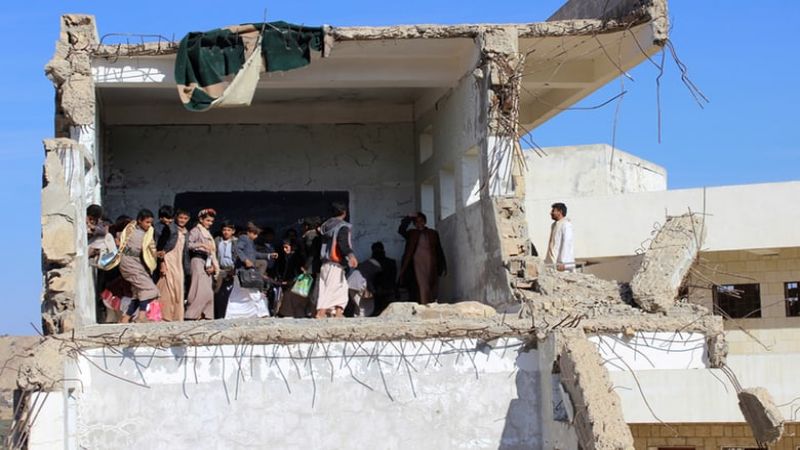
By Jonathan Kennedy
Over the past four months, Yemen has been ravaged by a cholera outbreak that the UN has branded the worst in the world. About 7,000 new cases are reported daily – 436,625 have been recorded since the end of April – and already there have been more than 1,915 deaths.
The epidemic is one aspect of a broader humanitarian emergency in Yemen. Two-thirds of the population – 18.8 million people – require some form of emergency aid. Food production has collapsed and 4.5 million children and pregnant and lactating women are acutely malnourished. Only 45% of health facilities are functioning, and 14.8 million people lack access to basic healthcare. About the same number require assistance to access safe drinking water and sanitation.
Cholera, a bacterial infection, is spread by water containing contaminated faeces. It can be easily prevented and easily treated. Cholera first spread from the Ganges delta in 1817, and the resulting pandemics killed tens of millions of people across the world over the 150 years. Modern improvements in water and sanitation infrastructure, and better access to medicines and healthcare, have brought a marked fall in the number of cases. Today, outbreaks occur chiefly in areas where water, sanitation and health systems are inadequate, or where they have been destroyed by natural or manmade disasters.
UN agencies, respected media outlets – including the BBC and New York Times – and influential medical journals such as the Lancet all argue that two years of conflict have created conditions conducive to a cholera outbreak. This narrative, while true, tells only part of the story. It fails to account for the possibility that one party might be more culpable for the outbreak and the other more affected by it.
The Yemeni civil war began in September 2014 when Houthi revolutionaries …, a group of Zaydi Shia from northern Yemen, took control of the capital, Sana’a, and then, with help from forces loyal to Ali Abdullah Saleh, the former president, overthrew the government the following January. The internationally recognized regime led by President Abed Mansour Hadi set up a parallel government in the southern port of Aden.
Since March 2015, Saudi Arabia has led a coalition of Sunni Arab states that has attempted to restore the government using airstrikes, an air and naval blockade, and ground troops. The US and UK provide the coalition with logistical support and military equipment. The Saudis have accused Iran of assisting the revolutionaries, but there is limited evidence for this claim and it is denied by the Houthis and Iran.
At least 10,000 people have been killed and 40,000 injured in the conflict. Both sides stand accused of disregarding the wellbeing of civilians and breaching international law. … But as the Saudi-led coalition commands far greater resources, it has been able to cause destruction of a totally different magnitude.
The Saudi air force has carried out indiscriminate attacks that have caused the majority of civilian deaths and injuries during the conflict. Airstrikes have targeted civilian infrastructure, including hospitals, farms, schools, water infrastructure, markets and the main port of Hodeida. They complement a Saudi-led naval and air blockade of rebel-controlled areas that has caused shortages of many essential items, including food, fuel and medical supplies.
It was not until four weeks after the start of the outbreak that the first plane carrying medical aid was allowed to land in Sana’a. The government no longer pays public employees working in Houthi-controlled areas. About 30,000 health workers have not received a salary for almost a year. Sanitation workers and water engineers in Sana’a have been on strike for months, leaving uncollected rubbish on the streets and municipal drains clogged.
So it is not surprising that rebel-controlled areas are disproportionately affected by the cholera outbreak. About 80% of cases – and deaths – have occurred in governorates controlled by the Houthis. In … Houthi-controlled areas the attack rate – the number of cases among every 1,000 people – is 17, compared with 10 in government-controlled governorates. The percentage of people with cholera who die is 0.46% in rebel-controlled areas, compared with 0.3% in government-controlled governorates. Thus, a person living in areas under rebel control is 70% more likely to contract cholera and, if they do, 50% more likely to die.
These numbers indicate that the outbreak is not simply an inevitable consequence of civil war. It is rather a direct outcome of the Saudi-led coalition’s strategy of targeting civilians and infrastructure in rebel-controlled areas. Criticism of the US and UK governments’ support for the Saudi-led intervention, this has not led to a policy change. In December 2016, the Obama administration banned the sale of precision-guided bombs to Saudi Arabia due to concerns about civilian casualties in Yemen, but in May 2017 the Trump administration agreed to sell $500m such weapons as part of a $110bn deal. The following month a bipartisan effort to stop the sale failed by a few votes in the Senate. Last month in the UK, the high court rejected activists’ claims that ministers were acting illegally by continuing to sell fighter jets and precision-guided bombs to Saudi Arabia when they might be used against civilians in Yemen. In the absence of strong international condemnation of Saudi-led operations, it is hard to foresee a quick end to this public health emergency and the broader humanitarian crisis.
Source: The Guardian, Edited by Website Team